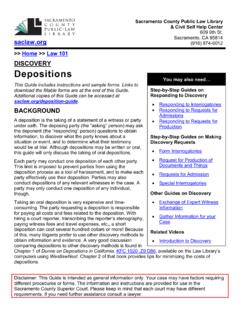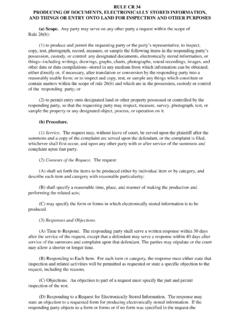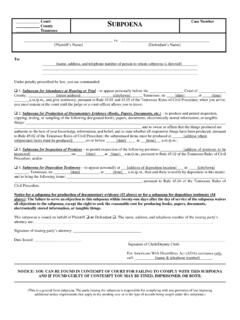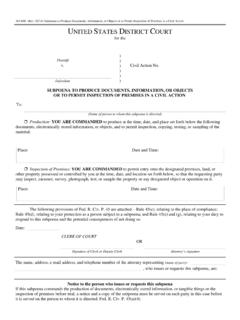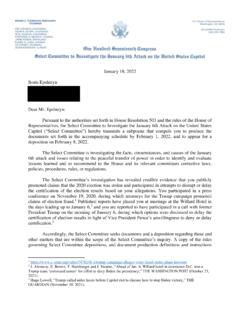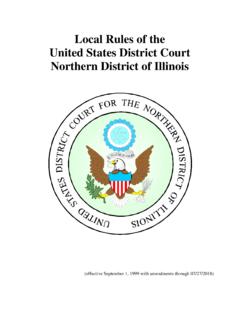Transcription of I. Issuing and Serving Subpoenas Under Rule 45
1 I. Issuing and Serving Subpoenas Under Rule 45 One of the most notable revisions to Rule 45 is its simplification of the rules governing the issuance of Subpoenas . Subdivision (a) of the revised rule now provides that a subpoena must issue from the court where the action is pending rather than from the court where compliance is Another significant change simplifies the rules governing where a subpoena may be served. Rule 45(b)(2) deletes the complex requirements of the previous version of the rule2 and now provides that [a] subpoena may be served at any place within the United States. Therefore, Subpoenas can now be served nationwide. In addition to simplifying the rules regarding Issuing and Serving Subpoenas , revised subdivision (a) of Rule 45 also emphasizes the requirement that a party that issues a document subpoena must provide notice to all other parties before Serving the subpoena.
2 Specifically, the rule now provides that if the subpoena commands the production of documents, electronically stored information, or tangible things or the inspection of premises before trial, then before it is served on the person to whom it is directed, a notice and a copy of the subpoena must be served on each party. While parties were required to provide notice of document Subpoenas Under the old rule, the Advisory Committee predicts that moving the language from subdivision (b) to subdivision (a) will provide the language greater visibility, noting that, in the past, parties Serving Subpoenas had frequently failed to provide notice as was required by the In addition, the revised rule now expressly requires the issuer to include a copy of the subpoena itself with the notice.
3 II. Place of Compliance Protections for Subpoena Recipients Under Rule 45 Another notable amendment to Rule 45 concerns limitations to the places at which Subpoenas may command compliance. Subdivision (c) of the new rule sets forth the geographical limitations governing Subpoenas and is intended to minimize travel burdens on subpoena recipients. Functionally, the new subdivision (c) collects the various provisions regarding geographic compliance contained in the previous rule and simplifies Subdivision (c) s limits on where a subpoena may command compliance is divided into two categories based upon the type of subpoena at issue. The first category deals with Subpoenas commanding attendance at a hearing, trial, or deposition.
4 The second governs Subpoenas commanding production of documents. With respect to Subpoenas that command attendance, a subpoena may only command a person to testify at a trial, hearing, or deposition if it is within 100 miles of where the person resides, is employed, or regularly transacts business in person. 5 Alternatively, a subpoena may also require compliance anywhere in the state 1 See Fed. R. Civ. P. 45(a)(2). The previous (and more complicated) version of the rule provided that a subpoena must issue as follows: (A) for attendance at a hearing or trial, from the court for the district where the hearing or trial is to be held; (B) for attendance at a deposition, from the court for the district where the deposition is to be taken; and (C) for production or inspection.
5 From the court of the district where the production or inspection is to be made. Fed. R. Civ. P. 45 (a)(2)(A)-(C) (2007). 2 Previously, the rule provided that a subpoena may be issued at any place (A) within the district of the Issuing court; (B) outside that district but within 100 miles of the place specified for the deposition, hearing, trial, production , or inspection; (C) within the state of the Issuing court if a state statute or court rule allows service at that place of a subpoena issued by a state court of general jurisdiction sitting in the place specified for the deposition, hearing, trial, production , or inspection; or (D) that the court authorizes on motion and for good cause, if a federal statute provides.
6 Fed. R. Civ. P. 45(b)(2) (2007). 3 See 2013 Advisory Committee s Notes on Fed. R. Civ. P. 45(a) (hereinafter 2013 Committee Notes ). 4 2013 Committee Notes on Rule 45(c). 5 Fed. R. Civ. P. 45(c)(1)(A). where the person resides, is employed, or regularly transacts business in person, provided that the person Under the subpoena s command is (i) a party or a party s officer, or (ii) is commanded to attend a trial and would not incur substantial expense. 6 As the Advisory Committee notes, this amendment resolves a split of authority in interpreting Rule 45 s provisions for subpoenaing parties and party officers. Specifically, it overrules cases decided Under former Rule 45 that held that a district court may compel a party or a party s officers to travel more than 100 miles, or to another state, to testify at Under the revised rule, the Committee explains, Rule 45(C)(1)(A) does not authorize a subpoena for trial to require a party or party officer to travel more than 100 miles unless the party or party officer resides, is employed, or regularly transacts business in person in the state.
7 8 Regarding Subpoenas that command the production of documents, Under the new rule, a subpoena may command production of documents, electronically stored information, or other tangible things within 100 miles of where the person resides, is employed, or regularly transacts business in The Advisory Committee notes that unlike the prior rule, place of service is not critical to place of compliance, and although Rule 45(a)(1)(A)(iii)10 permits the subpoena itself to direct a place of compliance, that place must be selected with the limitations of Rule 45(c) in III. Subpoena-Related Motions Under Rule 45 The revisions to Rule 45 also clarify the procedures for filing subpoena-related motions ( , motions to quash or modify Subpoenas ).
8 Most significantly, the rule requires such motions be made in the district where compliance is This revision to the prior rule is intended to protect local non-parties from undue travel burdens and Notwithstanding the above general rule on motions, the newly-added subdivision (f) to Rule 45 authorizes the court from the district where compliance is required to transfer subpoena-related motions to the Issuing court Under certain circumstances. To effect such a transfer, either the person subject to the subpoena must consent, or the court must find exceptional circumstances Rule 45(f) also provides that, if such a transfer occurs and the attorney for the person subject to a subpoena is authorized to practice in the court where the motion was made, the attorney may file papers and appear on the motion as an officer of the Issuing court.
9 15 Additionally, the new rule provides that for purposes of enforcing orders on transferred motions, the Issuing court may transfer its order to the court where the motion was made ( , the court from the district where compliance is required).16 6 Fed. R. Civ. P. 45(c)(1)(B). 7 See, , In re Vioxx Prods. Liab. Litig., 438 F. Supp. 2d 664 ( La. 2006). 8 See 2013 Committee Notes on Rule 45(c) (emphasis added). 9 Fed. R. Civ. P. 45(c)(2)(A). 10 Every subpoena must .. command each person to whom it is directed to do the following at a specified time and place. Fed. R. Civ. P. 45(a)(1)(A)(iii). 11 See 2013 Committee Notes on Rule 45(c). 12 See Fed. R. Civ. P. 45(d)(2)(B)(i) ( At any time, on notice to the commanded person, the Serving party may move the court for the district where compliance is required for an order compelling production or inspection.)
10 ; id. 45(d)(3) ( On timely motion, the court for the district where compliance is required must quash or modify a subpoena .. ); id. 45(e)(2)(B). 13 See 2013 Committee Notes on Rule 45(f). 14 Fed. R. Civ. P. 45(f). The new rule does not provide a definition for exceptional circumstances. But the Advisory Committee explains that transfer may be appropriate to avoid disrupting the Issuing court s management of the underlying litigation or when the Issuing court has already ruled on issues presented by the motion or the same issues are likely to arise in discovery in many districts. See id. 15 The Advisory Committee encourages judges to permit telecommunications to minimize the burden that such a transfer places on non-parties.

